Introduction to ClickUp Notifications
Staying on top of your work is tough. With so many projects, tasks, and conversations happening across tools and channels, it's easy to miss important updates.
That's where ClickUp notifications come in. With robust notification settings, you can configure ClickUp notifications to your project workflows. Get notified of what matters, where you want, without getting bombarded with noise.
One of the biggest pains when getting started with ClickUp is being swamped with notifications. As of June 2024, ClickUp has released a significant update that makes handling notifications much easier.
In this article, we'll explore how to configure ClickUp notifications settings and to effectively use ClickUp to manage your project notifications so you never miss a beat.
TL;DR
Q: How can I effectively manage notifications in ClickUp?
A: Enable only comment-related notifications and pick one channel only. Use smart notifications to delay alerts when active in ClickUp. Integrate with Slack for real-time updates.
Q: Where to find the ClickUp Inbox?
A: The ClickUp Inbox is located in the sidebar of your ClickUp interface. It's your central hub for all notifications within the app.
The Best ClickUp Notifications Settings in 2024
Check out this video to learn how to optimize your notification settings for better productivity!
Understanding ClickUp Notifications
ClickUp notifications consist of three main components:
- Triggers: What makes you a "watcher" of a task?
- Timing: When do you receive notifications?
- Content: What specific events or changes do you want to be notified about?
Let's look into each of these components and learn how to optimize them for a more productive workflow.
What is a Watcher in ClickUp?
A watcher in ClickUp is someone who receives notifications about activities on a specific task. You can see if you're a watcher by looking for the bell icon in the top right corner of any task. Being a watcher means you'll be notified about everything you've set up in your notification settings for that task.
Flexible ClickUp Notifications for Project Management
ClickUp notifications keep you updated on the activity in your spaces, folders, lists, and tasks.
Types of ClickUp Notifications
- Comments - New comments, mentions, replies
- Tasks - Assignments, status changes, updates
- Dates - Due date reminders, overdue notices
- Mentions - When you're mentioned in a task or document
- Sharing - When content is shared with you
- Integrations - GitHub, GitLab, Bitbucket, and more
Notification Channels in ClickUp
- In-app - Alerts within the ClickUp web and desktop apps through the inbox.
- Email - Sent to your inbox
- Mobile - Push notifications to your phone
- Browser - Enable browser notifications for pop-ups
Best Practices for Each Channel:
- Inbox: Keep this as your primary notification center.
- Email: Use sparingly, only for mentions (as a transition strategy).
- Browser: Turn off to reduce distractions. When enabled, these appear in the top right (Mac) or bottom right (Windows) of your screen.
- Mobile: Turn off unless absolutely necessary. Note: You must download the ClickUp mobile app to receive mobile notifications.
Configuring What to Get Notified About
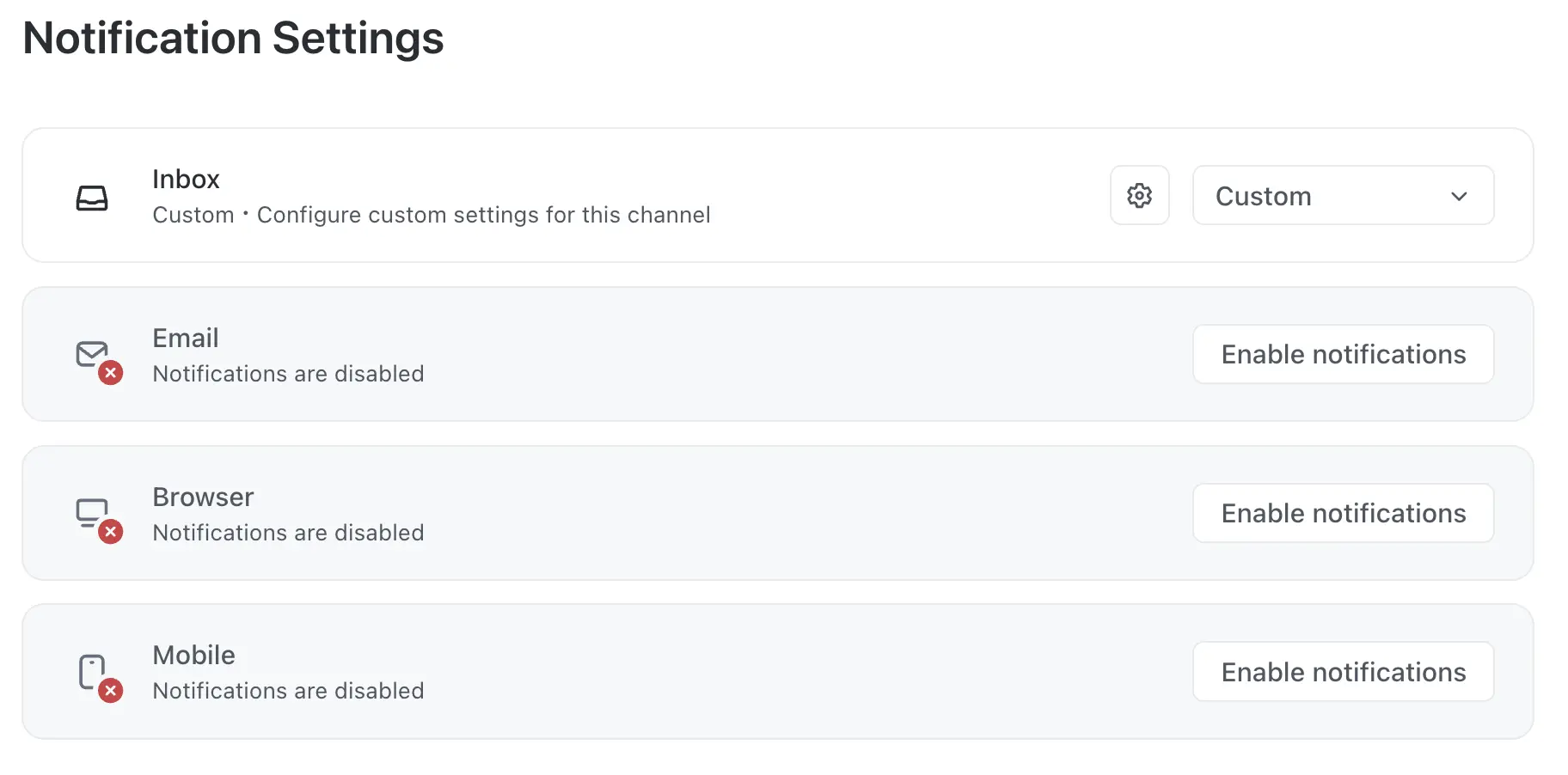
For each notification channel, you can customize what types of events trigger a notification. Here's the recommended setup:
Inbox:
- Keep only the default, mandatory notifications.
- Enable: Assigned comments, comments you're mentioned in, and new comments.
- Disable all other options.

Email:
- Set to "Mentions only."
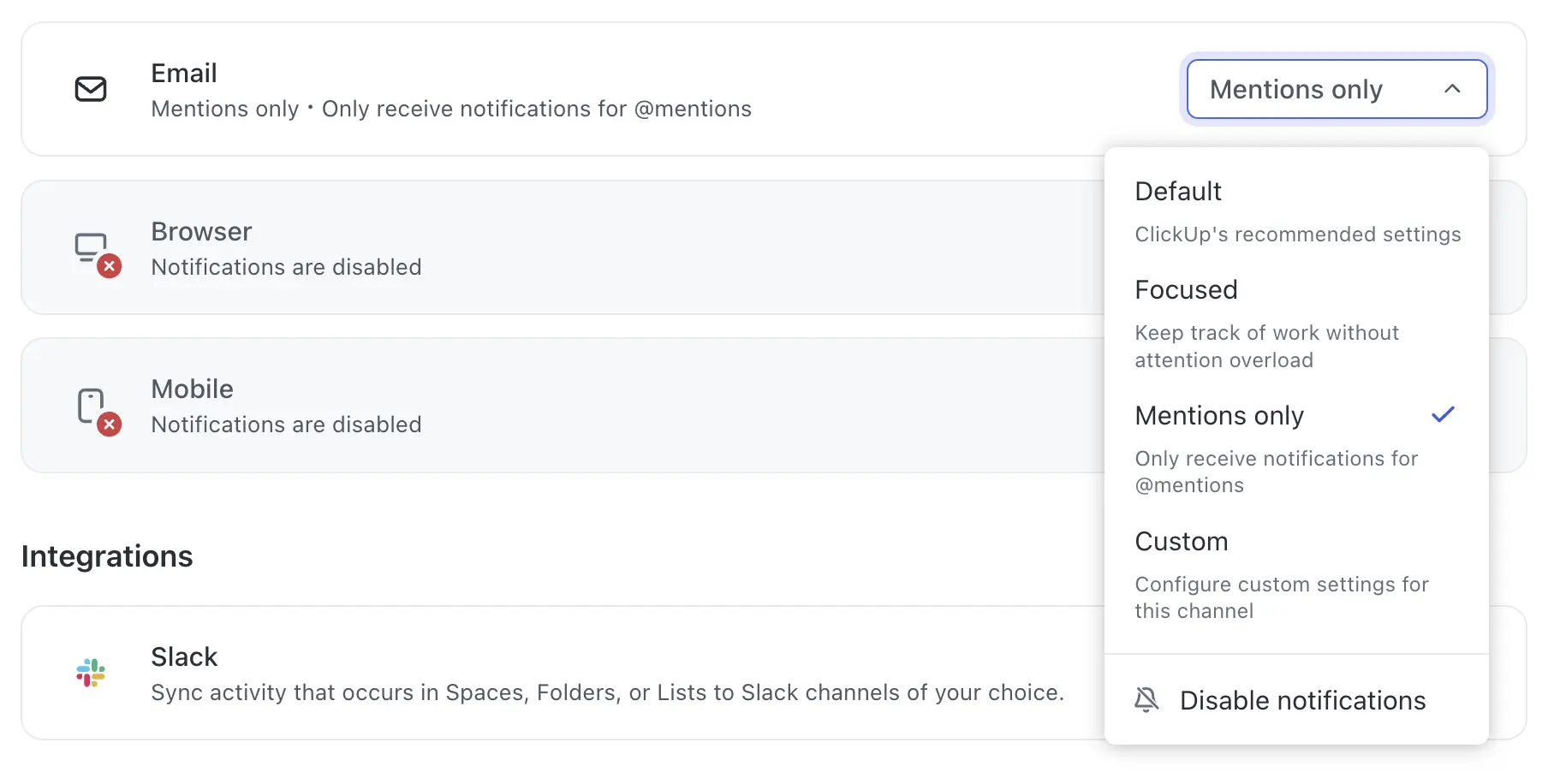
Browser and Mobile:
- Turn off completely.
Implementing These Changes
- Go to your ClickUp notification settings.
- Under "Emails," select "Mentions only."
- For "Inbox," click on "Custom Settings."
- Keep only the mandatory notifications on (assigned comments, mentions, new comments).
- Turn off all other options.
- Click "Save" to apply your new settings.
Initially, you might want to keep email notifications for mentions as you transition to using ClickUp more regularly. This ensures you don't miss important communications while you're building the habit of checking your ClickUp inbox frequently. Once you're comfortable with the ClickUp workflow, you can disable email notifications entirely.

Web notifications in the app can't be disabled. The other channels are optional.
With this flexibility, you can customize notifications to match your business workflow. Set each channel based on your needs. Use email and mobile for critical alerts. Rely on in-app and browser for lower-priority notices.
For example:
- Get email alerts for urgent assignments, mentions, and status updates to stay ahead.
- Enable push notifications on your phone for comments and reactions.
- Use in-app notifications to see updates when working in ClickUp.
The options are endless. You choose what's most convenient.
Setting Up Notification Triggers
To access your notification settings:
- Click on your avatar in the top right corner of ClickUp.
- Select "Notification Settings."
- In the "Auto watch tasks you're involved in" section, it's recommended to only enable the option "When I comment on a task or subtask." This ensures you're only set as a watcher when you're actively engaged in a task, rather than being notified about every task you create or edit.
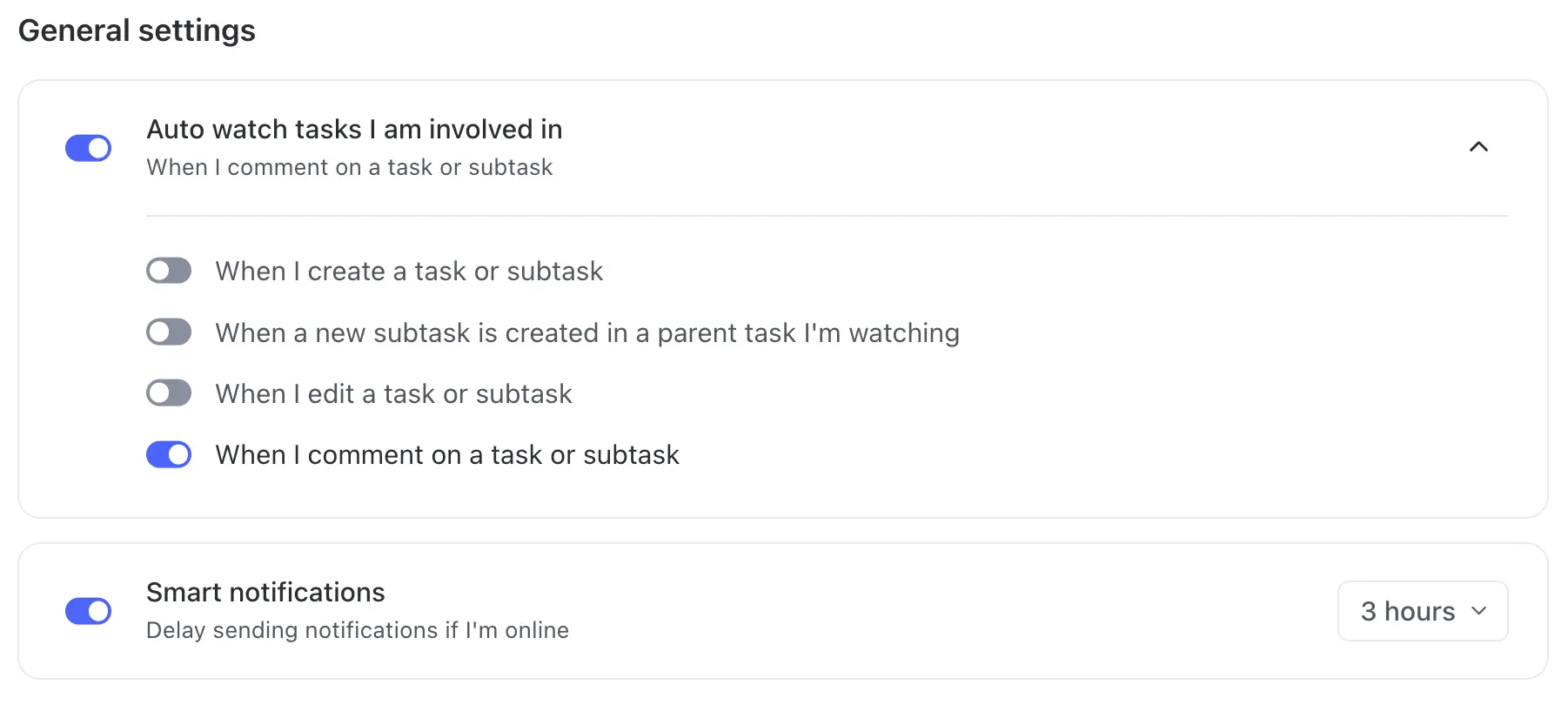
Customization of Workspace Notifications
ClickUp allows extensive customization of notifications for each ClickUp workspace.
The default settings will be overwhelming as you will notified on every channel, for everything. But you can fine-tune types of notifications, channels, and frequency.
Let's explore how to configure ClickUp notifications and update your preferences.
Step 1: Access ClickUp Notification Settings
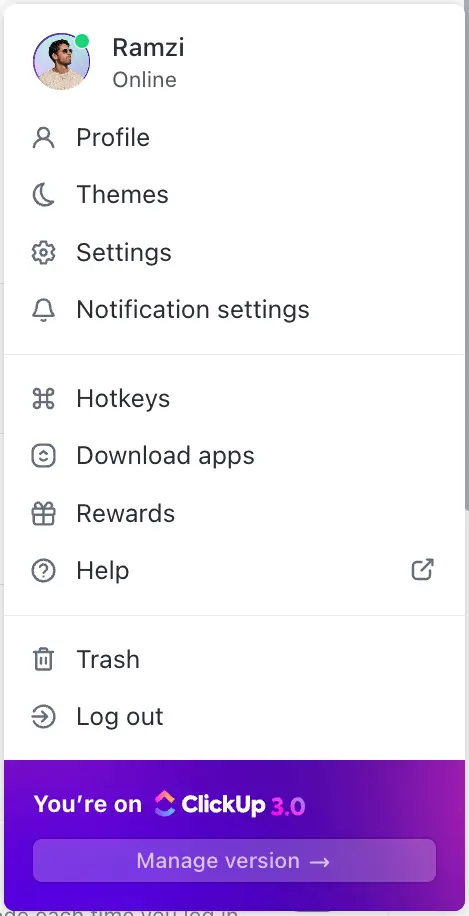
To modify settings:
- Click your profile icon on the top right
- Select "Notifications"
This opens your ClickUp notifications settings:Step 2: Update Base Settings for ClickUp NotificationsFrom here, you can update:
- Watcher settings - Get added as a watcher when creating/editing tasks
- Smart notifications - Delay notifications when active in ClickUp
- Notification channels - Email, mobile, web, browser
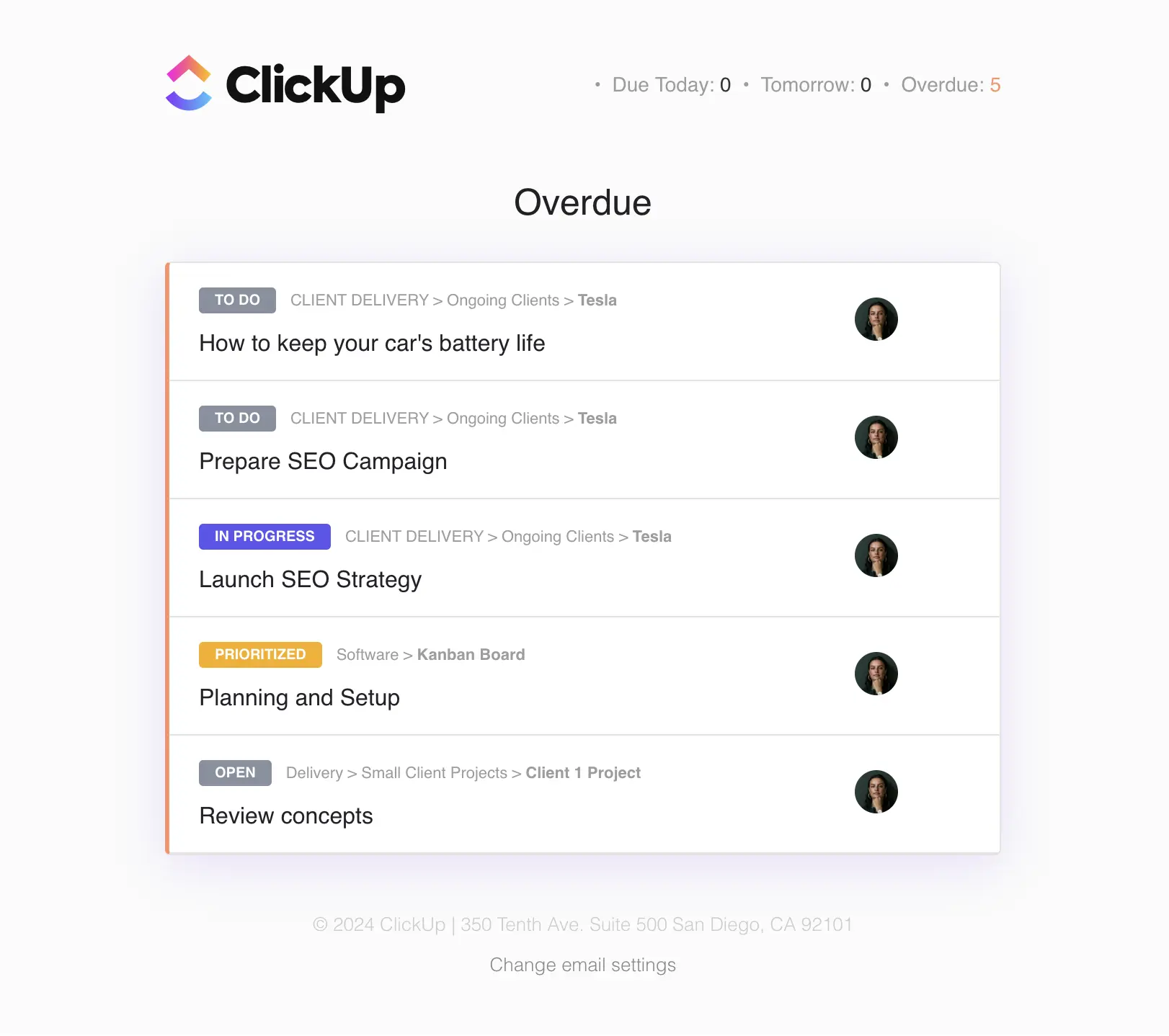
Step 3: Choose Specific ClickUp Alerts:
- Click the checkbox beside each notification type to enable or disable alerts.
- Turn off unnecessary notifications to reduce noise: comments, tasks, dates, apps, integrations, and more
How to Stop Receiving ClickUp Notifications for a Task
To stop getting notifications for a task in ClickUp, simply:
- Open the Task: Access the task you want to adjust notifications for.
- Access the Activity Panel: Look for the activity panel displayed in your screenshot.
- Click on "Unwatch": Select "Unwatch" to stop all notifications except for direct mentions or assignments.
This will make sure you are only notified for important interactions related to the task.
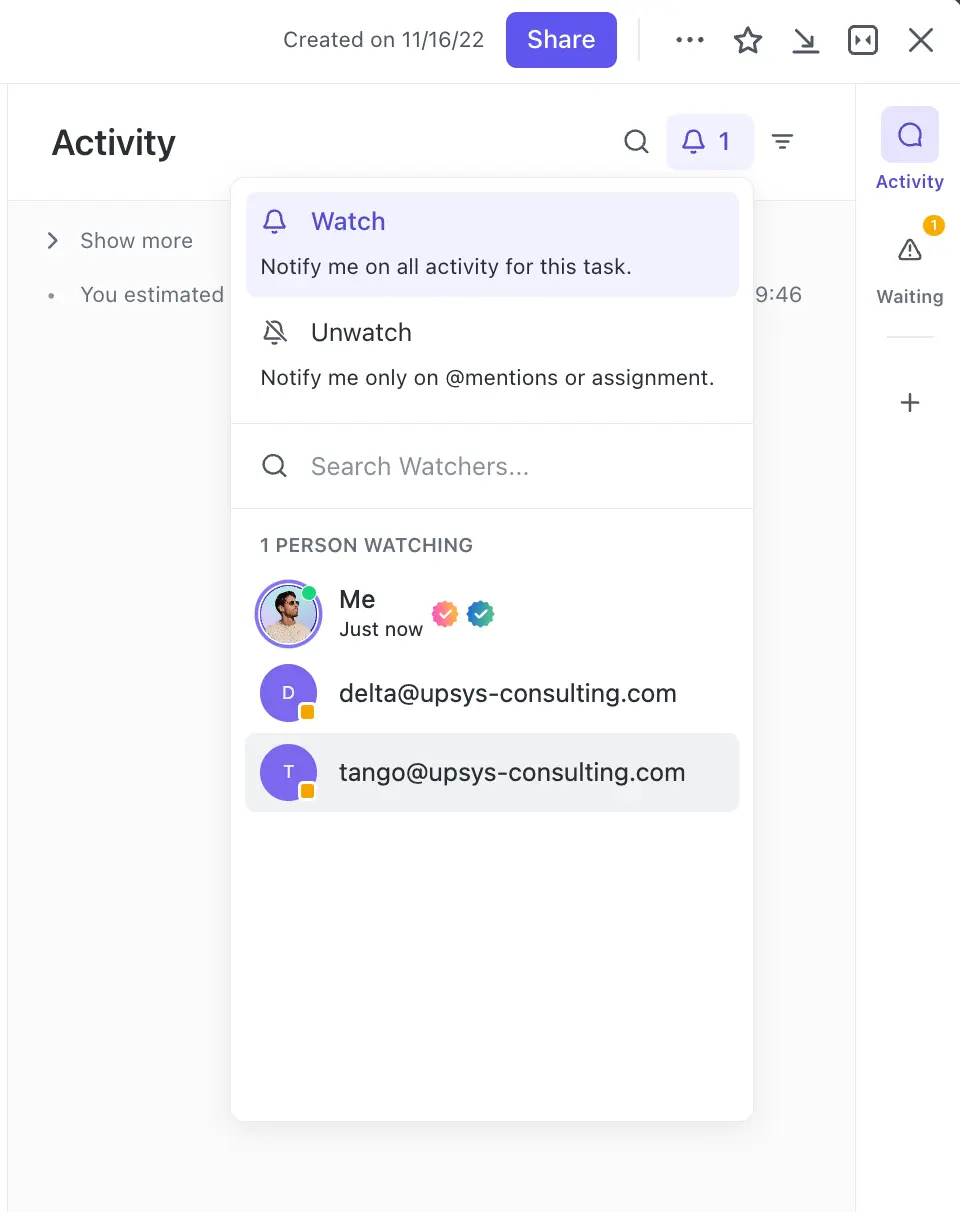
Essential ClickUp Notifications for Most Users
- Tasks assigned to me: Stay informed about your responsibilities.
- Due Date changes: Keep track of shifting deadlines.
- Comments I'm @mentioned in: Respond to direct mentions promptly.
- Start & Due Dates reminders: Get reminders for upcoming deliverables and overdue tasks.
- Dependency notifications: Stay updated on task dependencies that affect your work.
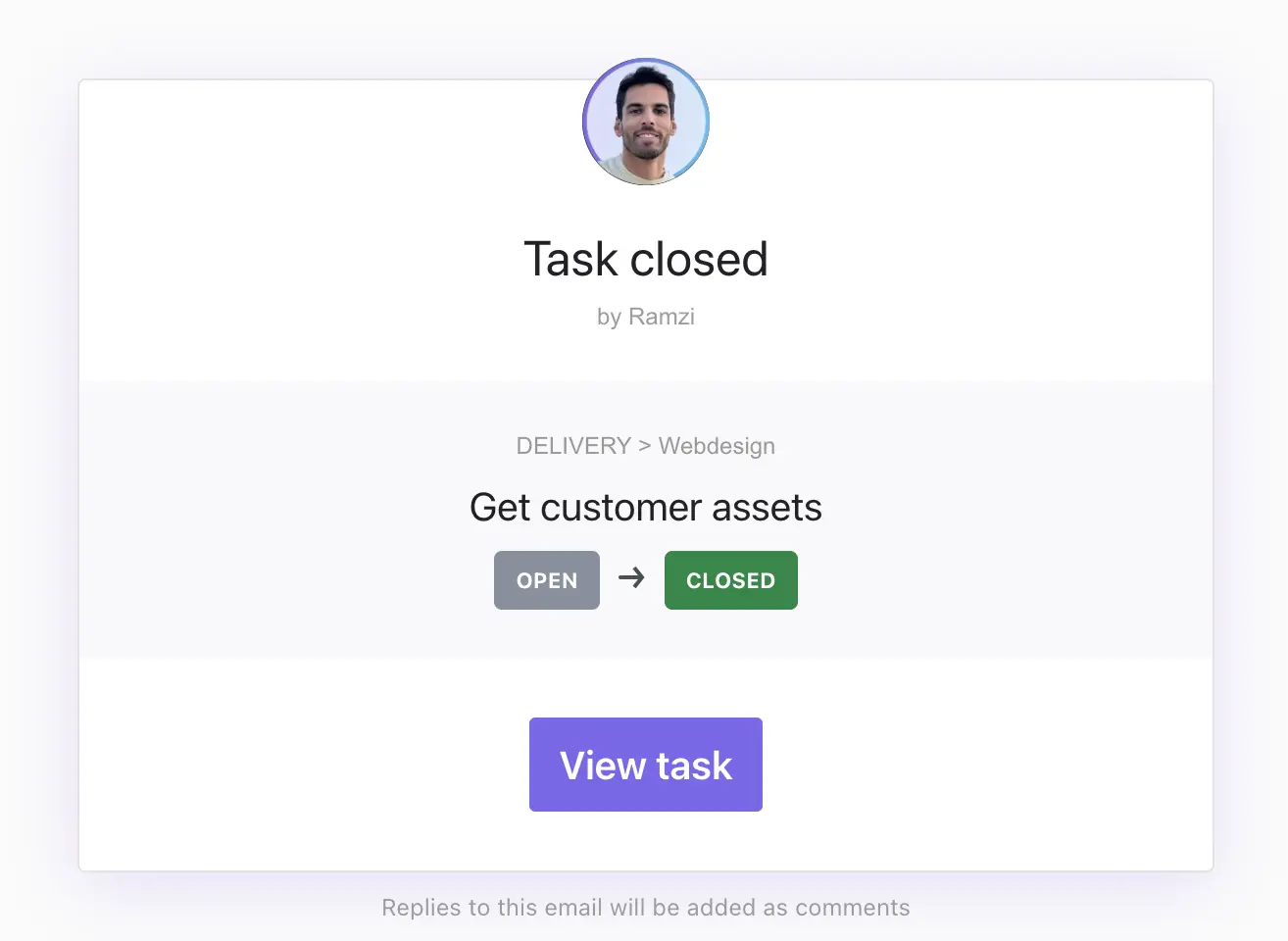
Configuring Notifications for Collaborative Work in ClickUp
Customize how you notify team members and external collaborators, including guests, keeping your team informed without clutter.
- Watcher settings: Choose based on how closely you want to follow tasks and subtasks.
- Assigned and Resolved comments: If you work closely with a team on comments.
- Status changes: If you need to know when the status of a task changes.
- Custom Field changes: If you use custom fields extensively in your workflow.

Specialized ClickUp Notifications for Advanced Use Cases
- Integrations (e.g., GitHub, GitLab, Bitbucket): If you use these tools.
- ClickApps notifications: If you utilize specific ClickApps.
- Sharing notifications: If you frequently share tasks, lists, folders, or docs.

Managing Mobile Notifications in ClickUp
The ClickUp mobile apps make it easy to manage notifications on the go.
In your app settings, you can:
- Enable/disable notification categories like tasks, comments, and mentions
- Turn notification sounds on or off
- Control notifications at the system level
You still have robust and process driven controls without needing to log in to the web app.
Customizing mobile notifications ensures you only get alerted on urgent updates on your phone or tablet.
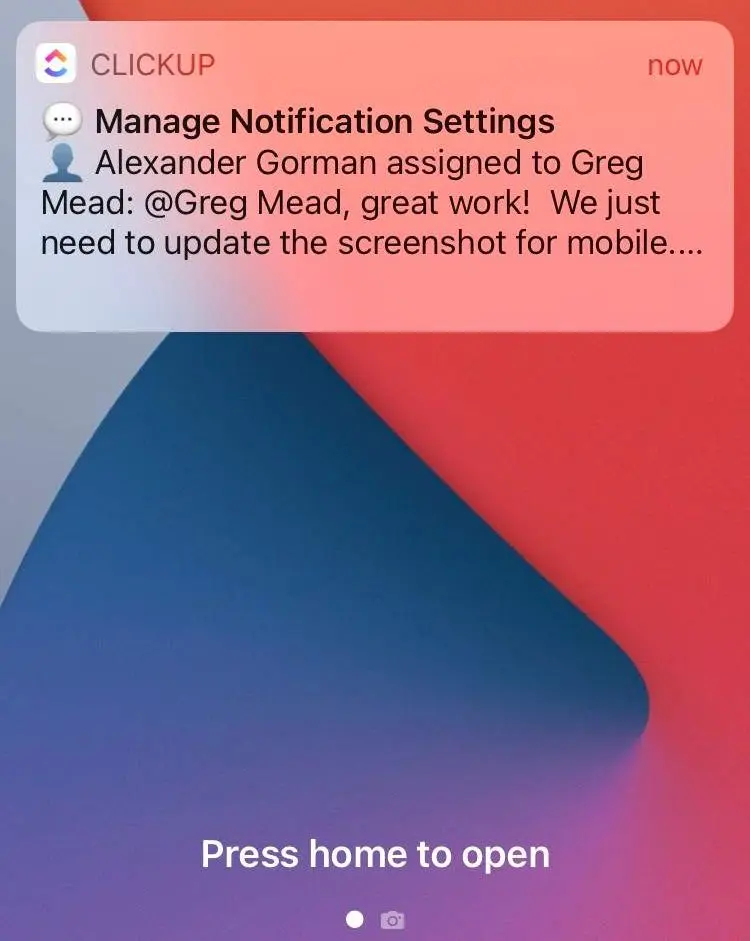
Desktop Notifications Management

Web Notifications Inside the App: When you use ClickUp on a web browser or the desktop app, notifications will appear on the Notifications page, which you can find in the Sidebar. You can see, delete, respond to, and reply to these notifications directly from your Inbox.
Even if you turn off ClickBot notifications for your Inbox, you will still get notifications about comments made through Automations.
Best Practices for Configuring Notifications
ClickUp notifications keep you connected to what matters most. With flexible configuration, you can enhance your productivity, manage your workload more effectively, reduce noise, and customize alerts to your workflow.
Some best practices include:
- Customize the timing of notifications:
- Use the Daily Summary - Get a daily digest email instead of real-time alerts
- Use Smart Notifications: Delay notifications when you're active on the web to reduce interruptions.
- Avoid redundancy: If you're watching a task, you may not need notifications for every subtask or comment.
- Choose the right channels: Decide whether you want notifications via Email, Mobile, In-App, or Browser.
- Keep mentions enabled to see direct pings.
- Enable push notifications for critical updates like assignments, approvals, and mentions
- Use email for important notices that need action
- Turn off unnecessary alerts to avoid distraction
- Make use of smart notifications. Delay notifications by at least 1h
- Set up Slack to get real-time updates as you work

Advanced Notification Tips
Get the most from your ClickUp notifications with these expert tips:
Get Notified Only for Comments
To focus on critical communications and reduce noise:
- Under "Watch" settings, enable only the "Comments" option.
- Disable notifications for task creation, editing, and other less critical activities.

Use Smart Notifications with Time Delay
ClickUp now offers a "Smart Notifications" feature, which allows you to delay notifications if you've recently been working on a task. Here's how to set it up:
- In your notification settings, enable "Smart Notifications."
- Set the delay time to 3-6 hours (3 hours is recommended).
This feature prevents you from receiving notifications about tasks you're actively working on, reducing interruptions and keeping your focus intact.

Use a Single Notification Channel
To streamline where you receive your notifications and avoid being overwhelmed:
- Deactivate all notification channels except for one, which could typically be Email notifications or ClickUp's Inbox. This strategy prevents you from getting bombarded with notifications across multiple platforms.
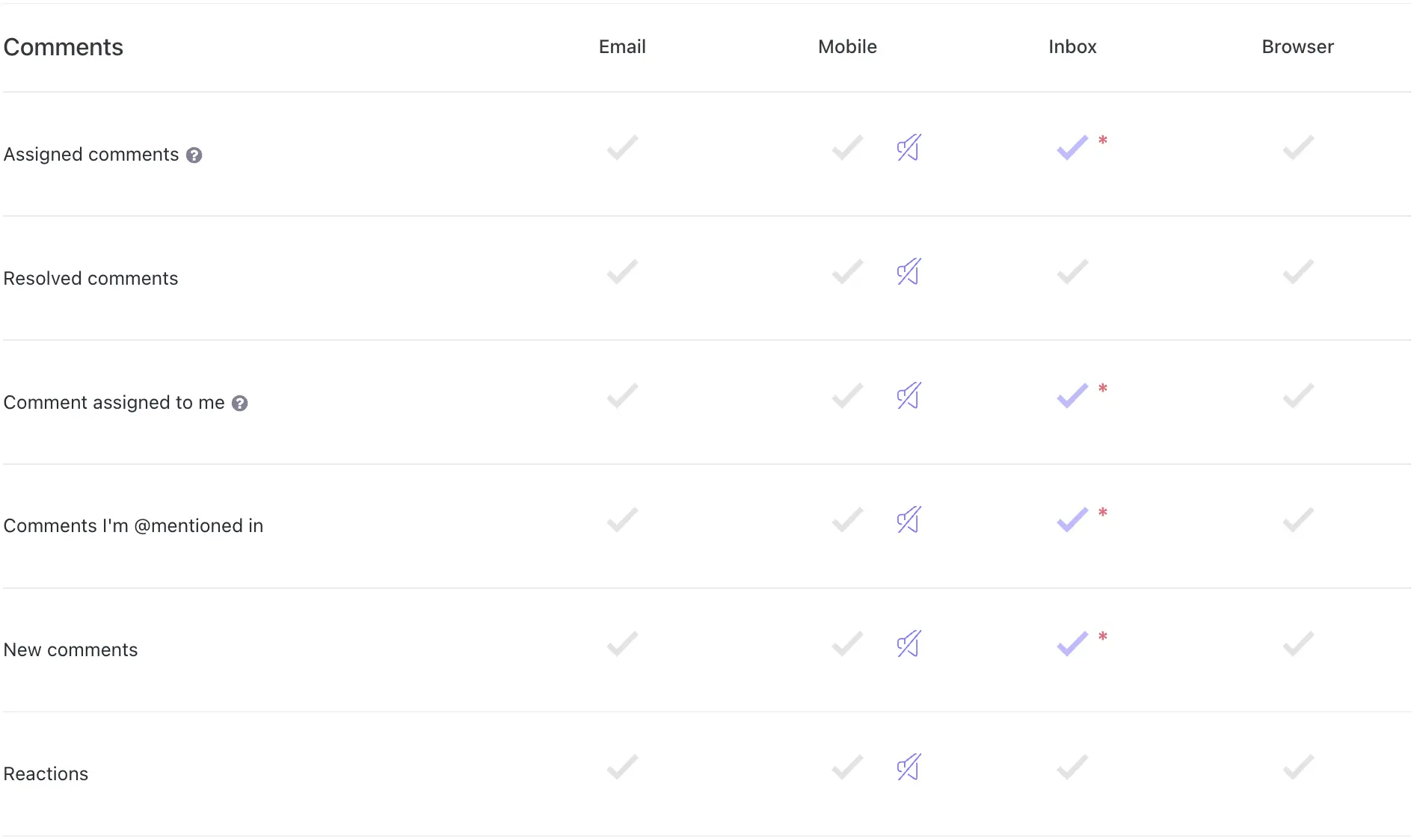
- As you become more comfortable with ClickUp, consider turning off email notifications entirely.
- Make checking your ClickUp inbox a regular part of your workflow.
- Use the ClickUp mobile app judiciously – only install it if you absolutely need on-the-go notifications.
ClickUp Slack Integration for Real-Time ClickUp Notifications
ClickUp also allows you to get notifications right within Slack.
With the Slack integration, you can receive real-time alerts as you work.
Get notified of:
- New tasks
- Status changes
- Comments
- Attachments
- Assignments
No need to toggle between apps.
To enable Slack notifications from ClickUp:
- Connect your Slack and ClickUp accounts
- Select a list/folder to track
- Choose the Slack channel for notifications
- Pick types of alerts
Once configured, you'll receive notifications as things happen in your ClickUp spaces.

Conclusion
With its extensive customization options, ClickUp empowers you to create a truly personalized notification experience tailored to your unique needs and work style. Receive alerts across multiple channels - email, mobile, in-app or browser - ensuring you never miss critical updates while minimizing distractions.
From smart notification delays and daily digests to integration with tools like Slack for real-time updates, ClickUp provides a comprehensive array of features. Leverage these capabilities to optimize your notification flow and maximize focus on high-priority tasks.
If you setup ClickUp notifications correctly, you will strike the perfect balance between staying informed and avoiding noise.
Got a project with ClickUp?
Book a call Now 🗓️Supercharge your business today








